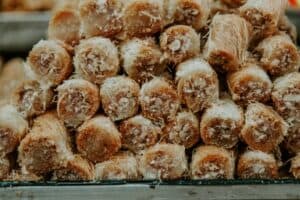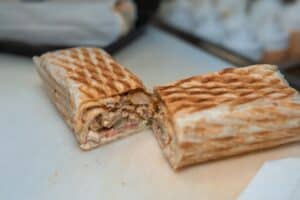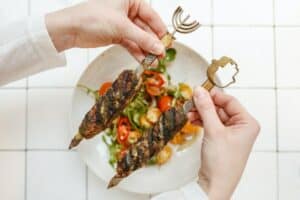Egypt has a diverse and rich cuisine that’s felt the influence of many other regions throughout its long history. As a food aficionado, you have to get a taste of Egyptian cuisine – it’ll surprise you beyond the stereotypical kebabs and shawarma.
Egypt is a country with a very particular culture that combines the influence of many nations to do historical expansions, invasions, and so on. We see parts and parts of Middle East and Europe impacts throughout various Egyptian museums. The local food culture is also a patchwork of multiple time periods of this ancient nation.
In addition, I guarantee you’ll be surprised at how many Egyptian dishes you frequently see in your life and don’t even know they are from that region! Can you guess what street vendors sell you Egyptian food “undercover”?
While you ponder on that, I’ll share the top 10 dishes you have to try as you come to visit the Pyramids.
Kushari
Kushari is the epitome of what I’ve mentioned before! This is an Egyptian patchwork of various other cuisines that combines in an authentic dish nevertheless. Kushari combines the traditional Indian rice and lentils (how did it get there? via British colonists, of course!), Italian pasta, and the local addition of tomato sauce and onions.
The resulting dish is a hearty one that can feed a grown man or two just by one serving! Koshari is sold everywhere in Egypt, so you’ll have no trouble finding it.
Kushari is vegan-friendly!
Ful Medames
 This one is a kind of local street snack, a similar one to sandwiches. Ful Medames is made of cooked fava beans that are mashed with garlic and olive oil. The mash is placed in pitas and sold by Cairo street vendors.
This one is a kind of local street snack, a similar one to sandwiches. Ful Medames is made of cooked fava beans that are mashed with garlic and olive oil. The mash is placed in pitas and sold by Cairo street vendors.
It is also a traditional breakfast food. In this case, Ful is served with eggs, cheese, Ta’miya, and a pita slice. To add freshness to the dish, you can serve it with some vegetables with tomatoes or cucumbers.
Ta’meya
 Speaking of Ta’meya, this one is a standalone dish of its own. This one you already know and have probably even tried!
Speaking of Ta’meya, this one is a standalone dish of its own. This one you already know and have probably even tried!
Ta’meya is an Egyptian falafel! And this one you’ll find served with everything there. This falafel is also made from fava beans. They are soaked overnight to soften and then crashed into a paste. Egyptians are fans of adding lots and lots of different spices to their falafels. Sometimes, the list comes up to 8-9 herbs! In the end, the flavorful paste is deep-fried.
Mulukhiyah
This one is a dish hard to love for tourists from the first try. I was not impressed initially either. But you’ll get the beauty of this dish later on.
Mulukhiyah is a local soup of mallow leaves. It’s worth mentioning that the dish is made of beef or chicken stew and often served with meat and rice. Some regions cook the soup using fish or shrimp, but the chicken version tastes the best.
Fattah
 On the contrary, Fattah is Egyptian food loved by tourists from the first bite! It has a long centuries-old history of feats, weddings, and other holidays.
On the contrary, Fattah is Egyptian food loved by tourists from the first bite! It has a long centuries-old history of feats, weddings, and other holidays.
Fattah has everything you need for a proper wholesome dish: a side of rice, meat (lamb or beef), aish baladi bread, all coated in tomato or vinegar sauce.
Fattah is quite a heavy and nourishing dish. So, if you are not used to heavy food, I suggest splitting this dish with your companion.
Masaa’a
If you want to try something similar to curry, search for Masaa’a in local cafes. The dish is made of eggplant, potato, and chickpeas. These ingredients are layered and seasoned with garlic, pepper, and spices.
The best thing about Masaa’a – it is even better than curry!
Pastry
 Egyptian sweets are a world of their own. The variety of sweets and desserts impressed me. And all of them are tasty. Fellow sweet-tooth travelers, you’ll like it there in Egypt.
Egyptian sweets are a world of their own. The variety of sweets and desserts impressed me. And all of them are tasty. Fellow sweet-tooth travelers, you’ll like it there in Egypt.
My favorite one is Um Ali – a mix of buttery pastry, pistachios, and raisins with sweet milk on top. This one is the most famous local dessert, and I fully understand why people love it so much.
Another favorite of mine is Baklava, which has roots from Ottoman Empire that spread throughout many countries. Egyptian Baklava differs from the Turkish one (that is probably “the original”) but is tasty nevertheless.
Qatayef is the traditional dish symbolism of Ramadan. These are cute sweet dumplings coated in sugary syrup. Inside is a stuffing made of cream and nuts.
Shawarma
 I know that shawarma is not the most original food you can try when visiting Egypt. After all, it is typical street food in so many countries that there are no surprises when it comes to this traditional Egyptian food. You can try shwarma even at the popular Italian food vendors.
I know that shawarma is not the most original food you can try when visiting Egypt. After all, it is typical street food in so many countries that there are no surprises when it comes to this traditional Egyptian food. You can try shwarma even at the popular Italian food vendors.
But there is one major factor that will make you buy local shawarma anyway – it is so damn good! I rest my case.
Hawawshi
For me, Hawawshi was the top pick for a busy lunch in Egypt. This dish is similar to a mince pie and a sandwich – you can easily eat it on the go and order as a takeaway.
As with many other Egyptian dishes, this mince pie can be rather spicy. If you are not used to lots of pepper (or haven’t visited a few Asian countries yet), ask for a milder version.
Kofta
 Kofta is a dish very similar to kebab. In fact, you won’t know the difference visually most of the time. Both of these dishes are grilled meat on a skewer. The difference is that kebab consists of chunks of lamb and kofta – of ground lamb. This is such a slight difference that both can be considered one tasty dish that only a vegetarian wouldn’t want to try.
Kofta is a dish very similar to kebab. In fact, you won’t know the difference visually most of the time. Both of these dishes are grilled meat on a skewer. The difference is that kebab consists of chunks of lamb and kofta – of ground lamb. This is such a slight difference that both can be considered one tasty dish that only a vegetarian wouldn’t want to try.
When you visit this exotic country, be sure to try all the mentioned dishes and compare some of them with the ones you’ve tried in other countries. It seems that Egyptians know some secrets that make those kebabs and falafels taste better locally.
Unlike many other countries, Egypt offers a variety of vegetarian dishes, which is certainly appreciated by many tourists. You’ll have no trouble finding to eat there.
What country’s cuisine do you think is the least vegan-friendly?

